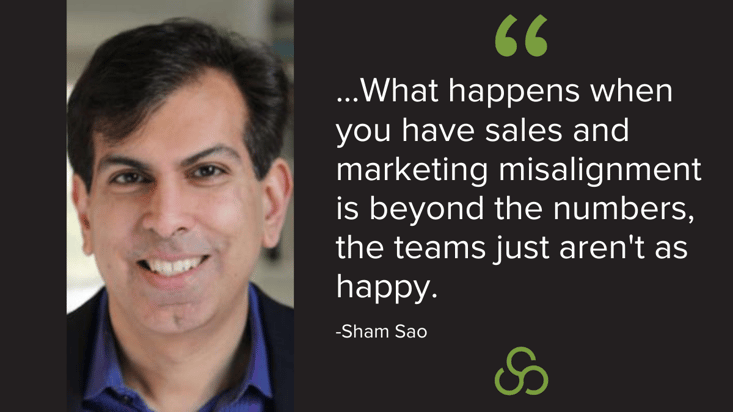
You've heard the term before; smarketing. It's when Sales and Marketing come together and align in a way that is effective for everyone. But it's not easy to do.
In this clip from the What Sales Can Learn From Series, Sham Sao shares his view on the impact of sales and marketing alignment on a growth focused organization.
Carole Mahoney:
We have some things in common, which was what caught my eye about your LinkedIn posts. You were talking about prospecting into target accounts at the level which really highlighted a lot of sales and marketing, which of course makes sense because I've interviewed Navy Seals, CIA agents, FBI directors in our last season. And I can tell you that this is a strategy that sounds a lot like what they're doing. You're in high stakes scenario, preparation, practice, all towards that target objective, right? It's the only way that we're going to win everything over.
So what's your view on how this sales and marketing alignment impacts growth in companies that are really focused on high velocity growth?
Sham Sao:
Yeah, it's really one of the most critical things. It's interesting you pointed out that post because that post actually wasn't meant to be about sales and marketing was actually, as you said, meant to be about prospecting. And it's so integral to everything that it actually became a substantial part of that post, even though that wasn't the original idea.
And in terms of quantifying impact, it's hard to quantify these kinds of things. How do you take an org that has bad sales and marketing alignment and compare it against one that, you can't really put these things into a test tube. But there's some data I've seen, actually I think it was on ZoomInfo's website. And they pulled stats from a few different places, MarketingProfs, Marketo, Sirius, Aberdeen, et cetera.
The stats, they were a little bit all over the place, but they really were consistent in that they all showed significant value. So 38% higher win rates, 36% higher customer retention, 24% increase in growth rates. Some of them were even higher. So they're all over, which makes sense because different organizations are different. But to me, what's critical is both in terms of the results as well as the impact on people, it was significant.
Carole Mahoney:
So it's interesting that you said people. My view on sales and marketing alignment has always been, ya know it's kind of like parents who are divorcing. They're arguing, but the person who's actually being hurt by all of that is the kid in the middle. And in this case, that kid is the buyer.
Those numbers are huge, but when you talk about the people at the end, can you tell me a little bit more what you mean about that?
Sham Sao:
Yeah. I mean, it's exactly what you said. It's the buyer. It's also the organization's ability to adapt because in the orgs that we work with, it's not usually a straight path, even when you are consistently growing and there's still a zigzag. And so what happens when you have sales and marketing misalignment is beyond the numbers, the teams just aren't as happy. Some people might become disengaged because they feel like the other team's always going to blame them no matter what. There's friction happening. Nobody wants to go to the meetings anymore because there's all this finger pointing. But when you get the teams aligned and they start really working well together, Not only do the numbers look better, but it makes people more relaxed. It lets them take risks. It makes them more creative.
So when you get those obstacles that we always get in these kinds of companies, people are more free-thinking to really say, "Okay, no problem. We've got an obstacle. How do we work together and break it down?" And they're just more thoughtful to come up with ideas and keep crunching forward.
The other thing is that the teams have naturally different things they're good at. So sales is really good at understanding a value prop and how it can be tailored to the person you're talking to. Marketing is really good at things like AB testing or segmented value props. And when you put them both together and they work together, they can really solve problems that you couldn't solve with one team really working on it.
Carole Mahoney:
Yeah. And if I can add one thing to that, it would be, you mentioned the creativity and the innovation that can happen within the teams. And when they're aligned together and they're all also in alignment with the buyer, I look at it as an opportunity for insights to come more clearly from the buyer through sales and into marketing for things like either product development or new packaging of services. Being able to not just keep pace with the customer, but being able to even anticipate needs, staying ahead of the market. I think that's one of those benefits to sales and marketing alignment that we don't pay enough attention to.
More about Sham Sao
Sham Sao has grown organizations from $3M to $20M, from $15M to $75M, and from $300M to $450M; served in roles including GM, CRO, CMO; led teams at McKinsey & Company, and advised companies growing 100-200% per year. He serves as GM and Board Director of think-cell, and founded Growth 11, which provides free insights and resources to companies focused on accelerating recurring revenue.
To learn more from Sham, follow him on LinkedIn, stay tuned to the Unbound Growth Youtube channel, or subscribe to the blog. To watch the full session on demand, click here!







